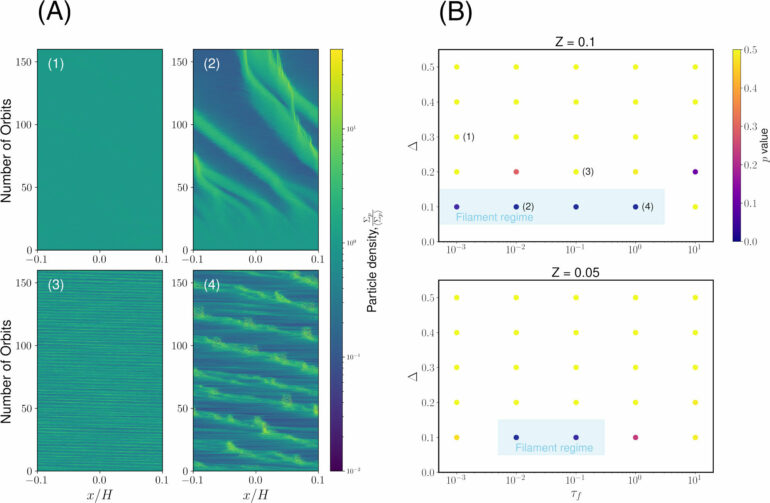Scientists around the world are constantly on the hunt for planets outside our solar system that could potentially provide a habitable environment for life.
Their telescopes, on the ground and in space, tend to focus on planets much larger than Earth, in part because they’re easier to spot than smaller planets, and thus more conducive to study.
But new research from the University of Rochester published in The Planetary Science Journal suggests scientists ought to be on the lookout for planets that are not much larger than our own. A rocky planet with a large moon may have good potential to host life, given that our moon controls essential aspects of life, including the length of the day, ocean tides, and stable climate.
“Relatively small planets similar to the size of Earth are more difficult to observe and they have not been the major focus of the hunt for moons,” says Miki Nakajima, an assistant professor of earth and environmental sciences at Rochester and the lead author of the research. “However, we predict these planets are actually better candidates to host moons.”
The details of the origin of the Earth’s moon are a longstanding debate in planetary science.
The prevailing theory is that the moon formed about 4.5 billion years ago when the Earth was hit by a planetary embryo the size of Mars. The collision threw into orbit a partially vaporized disk of debris that coalesced into the moon. Other models suggest that Earth collided with a much larger object, which would have produced a completely vaporized disk.
There are nearly 300 moons in our solar system, but their masses are typically much smaller relative to their host planets than our moon is to Earth—and that matters when it comes to the formation of life. Moons can form by other processes, but these moons are typically small compared to the sizes of their planets. In contrast, a huge impact tends to generate a massive moon.
While many scientists theorize that a moon isn’t necessary for a planet to sustain life, they also acknowledge that our disproportionately large moon played a crucial role in the development of complex lifeforms on Earth.
After all, it is the moon’s gravitational tug that is largely responsible for the tidal flow of the oceans, which scientists believe enabled the formation of the nucleic acids that fostered life as we know it. And the moon stabilizes Earth’s orbital tilt, which keeps the climate relatively predictable so organisms can more easily evolve and adapt.
Scientists have detected more than 5,000 exoplanets—planets beyond our solar system. But exomoons—moons that orbit exoplanets—are elusive because they are, by nature, so much smaller than the planets they orbit. To date, only a couple plausible candidates have been identified.
That may matter in the search for a second Earth, one that could offer an ideal environment for life—and this is where the latest science conducted by Nakajima and her co-authors comes in.
Building on previous research that relies on computer simulations of moon formations, they investigated the role so-called “streaming instability” plays in creating moons.
Streaming instability is a process that concentrates particles in a vapor disk to rapidly form planetesimals and moonlets, the foundational building blocks of planets and moons, respectively.
They found that while streaming instability can form self-gravitating moonlets in a vapor-rich disk generated by a giant collision of planets, those moonlets are not large enough to avoid strong drag from the vapor disk and being hurtled down to their host planet and destroyed.
“These moonlets could grow further once the disk cools enough and the vapor mass fraction of the disk becomes small,” the report reads. “However, by this time a significant amount of the disk mass is lost, and the remaining disk could make only a small moon.”
Nakajima was assisted in her research by Rochester physics professor Alice Quillen, former Rochester undergraduate student Jeremy Atkins, and Jacob Simon, an assistant professor at Iowa State University.
Their study supposes that the moon-forming impact has to be relatively “gentle.” That would mean, in the case of our Earth, the object colliding with it could not be much bigger than Mars. Otherwise, the impact would generate a completely vaporized disk, and such a disk could have only formed a fractionally small moon.
This work also suggests a major difference between planet and moon formation. Sometimes, moon-formation processes are viewed as analogous to the process of planet formation. This research suggests that streaming instability is a critical process for planet formation, but not for moon formation.
The researchers conclude that streaming instability is not conducive to forming large moons from vapor-rich disks, and that fractionally large moons, like Earth’s moon, stem from vapor-poor disks orbiting planets smaller than that of Earth.
The Space Telescope Science Institute recently selected two proposals from researchers to use the powerful James Webb Space Telescope to look for exomoons. One focuses on moons around a Jupiter-like planet, and the other looks for moons around Earth-like planets.
These future observations can test the theory developed in this research.
More information:
Miki Nakajima et al, The Limited Role of the Streaming Instability during Moon and Exomoon Formation, The Planetary Science Journal (2024). DOI: 10.3847/PSJ/ad4863
Provided by
University of Rochester
Citation:
In the hunt for a second Earth, look to small planets, says new research (2024, June 18)



